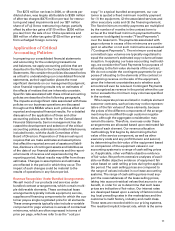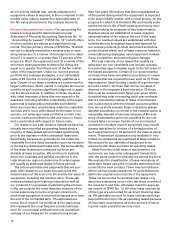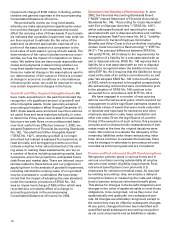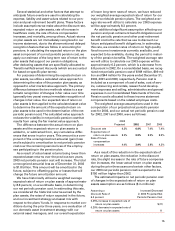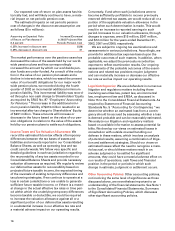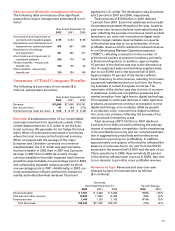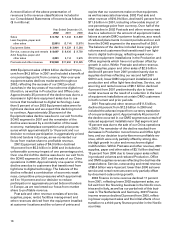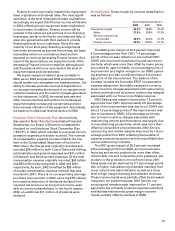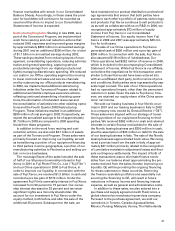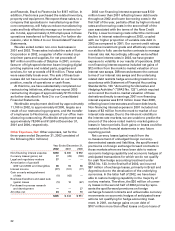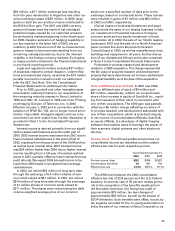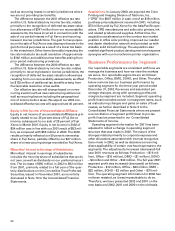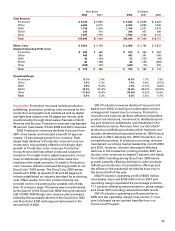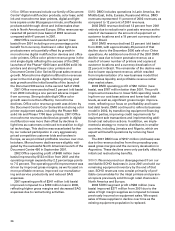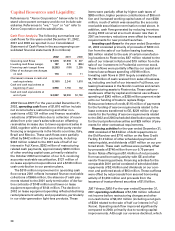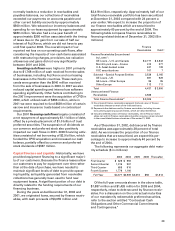Xerox 2002 Annual Report Download - page 23
Download and view the complete annual report
Please find page 23 of the 2002 Xerox annual report below. You can navigate through the pages in the report by either clicking on the pages listed below, or by using the keyword search tool below to find specific information within the annual report.
21
finance receivables will remain in our Consolidated
Balance Sheets. Accordingly, in these cases the provi-
sion for bad debts will continue to be recorded as
usual and therefore no impact to our Consolidated
Statements of Income is expected.
Restructuring Programs: Starting in late 2000, as a
part of the Turnaround Program, we implemented
work force resizing and cost reduction actions that
reduced SAG expenses and improved gross margins
by approximately $800 million in annualized savings
during 2001 and an additional $300 million, for a total
of $1.1 billion in annualized savings during 2002.
These savings resulted from reducing layers of man-
agement, consolidating operations, reducing adminis-
trative and general spending, capturing service
productivity savings from our digital products and
tightly managing discretionary spending. We reduced
our costs in our Office operating segment by moving
to lower cost indirect sales and service channels
and by outsourcing our office products manufacturing.
In 2002, we implemented additional restructuring
initiatives under the Turnaround Program related to
additional worldwide employee severance actions,
reflecting continued streamlining of existing opera-
tions, the elimination of redundant resources and
the consolidation of activities into other exisiting opera-
tions and the Fourth Quarter 2002 Restructuring
Program. These initiatives resulted in an additional
$200 million of cost savings in 2002. Prospectively, we
expect the annualized savings to be of approximately
$1.7 billion in 2003 as compared to 2000 spending
levels from these programs.
In addition to the work force resizing and cost
reduction actions, we also sold $2.7 billion of assets
as part of the Turnaround Program. These sales were
primarily focused on improving our liquidity, as well
as transitioning a portion of our equipment financing
to third parties in some geographies, a portion of our
manufacturing activities to Flextronics and exiting cer-
tain non-core businesses.
The most significant of the sales included the sale
of half of our 50 percent ownership interest in Fuji
Xerox in 2001 to Fuji Photo Film Co., Ltd. (“Fuji Film”)
and our China operations in 2000 to Fuji Xerox, in
order to improve our liquidity. In connection with the
sale of Fuji Xerox, we received $1.3 billion in cash and
recorded a pre-tax gain of $773 million. Under the
agreement Fuji Film’s ownership interest in Fuji Xerox
increased from 50 percent to 75 percent. Our owner-
ship interest decreased to 25 percent and we retain
significant rights as a minority shareholder. We
account for our investment in Fuji Xerox under the
equity method, both before and after the sale of the
additional 25 percent. Subsequent to the sale, we
have maintained our product distribution and technol-
ogy agreements that ensure that both parties have
access to each other’s portfolio of patents, technology
and products. Fuji Xerox continues to sell products to
us as well as collaborate with us on R&D. In 2000, we
recognized approximately $73 million of equity
income from Fuji Xerox in our Consolidated
Statement of Income. Our equity income from Fuji
Xerox in 2002 and 2001 was approximately $45 mil-
lion for both years.
The sale of our China operations to Fuji Xerox
generated cash of $550 million and a pre-tax gain of
$200 million. In connection with the sale, Fuji Xerox
also assumed $118 million of indebtedness. Our
China operations had $262 million of revenue in 2000,
which is included in the accompanying Consolidated
Statement of Income. While Fuji Xerox is our affiliate,
we believe the negotiations for this transaction were
similar to those that would have been entered into
with an unaffiliated third party, both in terms of price
and conditions. Both parties were represented by sep-
arate legal counsel. The sale of our China operations
had no operational impact, other than the permanent
reduction in sales. Given the sale to Fuji Xerox, how-
ever, we retained our equity share of the China opera-
tions’ net income.
We sold our leasing business in four Nordic coun-
tries in 2001 and our leasing business in Italy in 2002
to a company now owned by General Electric (“GE”).
These sales were aligned with our strategy of transi-
tioning portions of our equipment financing to third
parties. We received $352 million in cash and retained
interests in certain finance receivables for the sale of
the Nordic leasing business and $200 million in cash,
plus the assumption of $20 million in debt for the sale
of our leasing business in Italy. The sale of the Nordic
leasing business approximated book value. We recog-
nized a pre-tax loss from the sale in Italy of approxi-
mately $27 million primarily related to the recognition
of cumulative translation adjustment losses and final
sale contingency settlements. The impact of both of
these transactions was to eliminate finance receiv-
ables from our balance sheet approximating the pro-
ceeds received from the sales, thereby improving our
liquidity. GE will be providing the ongoing financing
for these customers in these countries. Removing
the finance receivable portfolios and essentially out-
sourcing the financing to GE, will result in future
reductions in finance income and financing interest
expense, as well as general and administrative costs.
In addition to these sales, we also entered into a
purchase and supply agreement with Flextronics, a
global electronics manufacturing services company.
Pursuant to the purchase agreement, we sold our
operations in Toronto, Canada; Aguascalientes,
Mexico; Penang, Malaysia; Venray, The Netherlands


